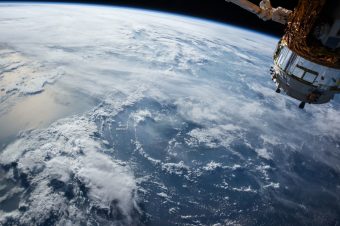
Space-based observations are key to achieving the international agenda on sustainable development, disaster risk reduction and climate change and it is thus imperative to ensure there is a stable and sustainable space-environment.
This was one of the take-home messages of a high-level panel event on civil space issues organized by the French diplomatic mission to Geneva and hosted by the World Meteorological Organization. It brought together the heads of WMO, the International Telecommunications Union, UN Office on Outer Space Affairs and the European Space Agency, as well as the Chief executive Officer of Arianespace and the director of France’s Foundation for Strategic Research.
WMO Secretary-General Prof Petteri Taalas underlined how space observations are a fundamental part of Earth-system monitoring – even though ground-based measurements and vertical profile measurements like radiosondes remain necessary.
The space-based observational capabilities have greatly improved since the launch of the first weather satellites in the early 60s. Today they provide high-precision observations of a wide range of parameters and are a key input for global numerical weather prediction models, underpinning most application areas and the services of all WMO Members, enabling the protection of life and property. This allows us not only to monitor the weather, climate and water, but also to assess the health of the environment and the extent to which human activities are sustainable.
More:
The impressive progress made in recent years in weather, water and climate analysis and forecasts, including warnings for hazards such as tropical cyclones is to a great extent attributable to satellite data and the assimilation of space-based observations in numerical models. This has narrowed the forecast accuracy gap between the northern and southern hemisphere, Prof. Taalas told panelists.
With almost 200 Earth observation satellites now in operation, it is clear that spaceborne sensing of the Earth’s surface and atmosphere will continue to play an increasingly important role in operational and research meteorology, disaster monitoring and Earth system monitoring in general, said Prof. Taalas.
It will also inform better scientific understanding, monitoring and prediction of climate change indicators and its impacts – ocean heat, sea level rise and ice melt – as well as air quality and anthropogenic emissions of greenhouse gases, critical for the implementation of the Paris Agreement.
Radio Frequencies
Spaceborne sensing for meteorological applications is performed in specific radio-frequency bands. These bands are determined by fixed physical properties (molecular resonance) that cannot be changed or ignored, nor can these physical properties be duplicated in other bands. Therefore, these frequency bands are an important natural resource.
In the more critical passive sensing frequency bands, the Table of Frequency Allocations in the international Radio Regulations states that “all emissions are prohibited”, enabling in principle the deployment and operation of sensors with the highest reliability.
However, experience has shown that in some cases this protection is jeopardized due to unregulated, and in some cases by mass-market short-range devices allowed nationally to operate in these bands or by unwanted poorly controlled emissions from adjacent bands, putting increasing pressure on the frequency bands used for meteorological purposes.
Prof. Taalas told the high-level panel session that WMO continues to work with ITU to try to ensure the protection of vital Earth observation satellite systems essential and will present its findings and concerns at the next World Radiocoimmunication Conference 2023 (WRC-23).
Source: WMO



